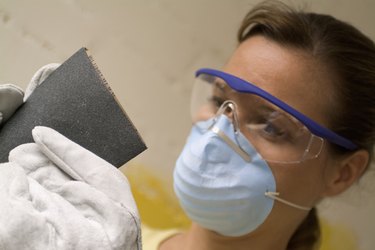Things You'll Need
Sander
Wood glue
Pin nailer
Nails
Drill
Pilot bit
Screws
Clamps
Contact cement
Roller
Solvent-based wood filler
Auto-body putty

MDF, or medium density fiberboard, is an updated version of particle board. With a much-improved texture and resistance to moisture, MDF has become a staple of the cabinet and furniture-making industry. MDF can be worked with standard woodworking tools, is comparatively inexpensive, and attaches using standard fasteners and adhesives. Since MDF is used as a countertop substrate, it is frequently attached to materials such as wood veneer and plastic laminate.
Step 1
Sand the edges and faces of MDF pieces that will have anything attached to them. Wood glues work primarily by soaking into the surface of each piece, then hardening to create a sort of weld between the pieces. Any substance that seals the surface of the MDF and prevents the glue from soaking in will make your joints less effective.
Video of the Day
Step 2
Attach MDF to MDF using standard adhesives and fasteners. Use carpenter's white wood glue, PVA or hide glue to create joints between MDF pieces. Because of its more brittle texture and being heavier than plywood or hardwood, fasteners, such as nails or screws, should be employed to hold the joint in place as the adhesive is curing. Bar clamps and other wood working clamps can also be used to support heavier pieces while the adhesive hardens.
Step 3
Drill pilot holes in any pieces that will be attached using screws. MDF is less flexible than plywood or hardwood and will have a tendency to split if fasteners are driven into unprepared MDF. Air nailers work better than hammering finish nails into the fragile edges. The impact from the hammer can dent the face of the material and hand-finish nails are typically thicker than their air-driven counterparts.
Step 4
Roll or spray a coat of contact cement onto the surface of MDF to be attached to countertop laminate or wood veneer. A second coat should also be applied to the back of the material being attached to the MDF. Allow this adhesive to dry to the touch before pressing the two pieces together. Roll the laminate or veneer with a roller to press air pockets from underneath the material and ensure a good joint.
Step 5
Repair the surface of MDF with a solvent-based wood filler or two-part auto-body repair putty. The pores of MDF are too small to allow standard wood fillers and putties to attach well and the repair will have a tendency to detach from the face of the MDF.
Video of the Day